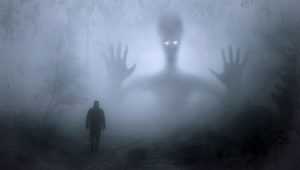In the Gospel of Truth, the Parable of Nightmares asks: How do you escape a nightmare?
The classic horror film A Nightmare on Elm Street directed by Wes Craven has as a key plot point the idea that one has to wake up. Of course, this is easier said than done– especially since nightmares can bleed into the real world. In the movie this takes the form of the monstrous Freddy Kreuger, Craven pointed to real-world inspirations for the concept.
For example, Craven discussed reading an L.A. Times article in which a family which escaped the brutal Killing Fields in Cambodia, but one of the children continued to have worsening and worsening nightmares, culminating in their death in the middle of the night. Articles like this might be what Craven was referencing. It’s a horrifying concept– being trapped in a nightmare is bad enough, but for that nightmare to ruin your waking life as well is that much worse. And if nightmares can even result in real death, perhaps there is a kind of reality to the nightmare itself?
The Gospel of Truth is an early Christian text that is considered non-canonical; it was likely written by Valentinians, though there is some disagreement among scholars. In this text is offered the Parable of Nightmares. What is this parable, what does it mean, and how can we learn to wake up? Click below to learn more!
Table of Contents
Key #1: Understand the Mythological Context
To begin, let’s start by unpacking the Parable of Nightmares. Here is the full text of the parable:
What, then, did he want them to think of themselves? He wanted to them to think, “I’ve come into being like the shadows and phantoms of the night.” When the light shines on the terror which they received, they know that it’s nothing. In this way, they were ignorant of the Father, whom they didn’t see.
Since it was terror and disturbance and instability and doubt and division, many illusions were at work among them, and vain ignorance, like they were deep in sleep and found themselves in nightmares. Either they’re running somewhere, or unable to run away from someone; or they’re fighting, or being beaten; or they’ve fallen from heights, or fly through the air without wings. Sometimes, too, it’s like someone is killing them, even though no one’s chasing them; or they themselves are killing those around them, covered in their blood.
Until those who are going through all these nightmares can wake up, they see nothing, because these things are nothing.
That’s the way it is with those who’ve cast off ignorance like sleep. They don’t regard it as anything, nor do they regard its other works as real, but they abandon them like a dream in the night. They value the knowledge of the Father like they value the light.
The ignorant have acted like they’re asleep; those who’ve come to knowledge have acted like they’ve awakened. Good for the one who returns and awakens! Blessed is the one who’s opened the eyes of those who can’t see! The Holy Spirit hurried after them to revive them. Having given a hand to the one who lay on the ground, it set them up on their feet, because they hadn’t yet arisen.
It gave them the knowledge of the Father and the revelation of the Son, because when they saw him and heard him, he granted them to taste him and to grasp the beloved Son.
In order to understand this text, let’s first talk about its context within the Gospel of Truth. According to this text, the Father is a “hidden mystery”, of which we are ignorant. Jesus Christ is our savior because he has come to redeem those who are ignorant of the Father.
Why are we ignorant of the Father? Because he is “incontainable, inconceivable… beyond every thought”. He is above and beyond our capacity to comprehend. Our limitations result in our ignorance.
This ignorance caused us to grow anguished and terrified, strengthening the forces of Error, which sought to use power and beauty to create a substitute for Truth. Jesus came to save us from Error, from substitute Truth, by showing us a Way: the Truth which he taught.
Error was angry at Jesus and was responsible for Christ’s crucifixion, but through his death Christ revealed the ultimate Truth of the Father; thus, what Error perceived to be victory was in reality the beginning of its downfall.
Christ came, then to save us from Error. To save us from forgetfulness and ignorance. To save us from the nightmare which we perceive to be reality, but which is actually a cheap substitute for Truth.
Key #2: The Nightmares of Ancient Times Are Relatable to Us, Today
What were the nightmares of people writing at the time of the Gospel of Truth? Consider what the Parable of Nightmares describes:
- The dreamer is “running somewhere”
- The dreamer is “unable to run away from someone”
- The dreamer is “fighting”
- The dreamer is “being beaten”

- The dreamer is “falling from heights”
- The dreamer can “fly through the air without wings”
- The dreamer experiences someone “killing them”
- The dreamer experiences “killing those around them”
It’s easy to think of those living millennia ago as being fundamentally different from us today, but think about how often those dreams show up in modern contexts. One study found that falling, being an aggressor/fighting, and being chased are among the most common kinds of nightmares. And flying was a common enough dream to write about in the Gospel of Truth many centuries before the invention of airplanes. Astounding!
When ancient writers speak of dreams and nightmares, we should pay attention. Their context was different, but they were human, just like we are, and their dreams– and nightmares– echo our own.
Key #3: The Relationship Between Dreaming and Ignorance
The Gospel of Truth explains that, in the Parable of Nightmares, those who have woken from their nightmares and recognize them for what they are no longer experience terror from them. And yet, while we are in a nightmare, it seems so real– it is real, for us, subjectively.
Similarly, as we find ourselves in this world, the Gospel of Truth calls us to recognize that we are trapped here, in this nightmare. We are in a world where God is unknown and unknowable. Where innocents suffer. Where violence and tragedy strike without cause. Where the unjust reign and the just are punished.
This world is clearly in a state of error– or as the text would personify it, Error. What is the nature of Error? In the Gospel of Truth, it is not possible to fix Error. It is not possible to rectify the broken human psyche, or the inevitability of suffering and tragedy, or the inevitability of death. What we can do, however, is to be aware of it, and to recognize that it is not the true expression of the Father. It is not how things ought to be. It is a nightmare.
Key #4: We Cannot Escape Night; We Can Have Faith in Dawn
In the text, it would be great if we could simply leave the nightmare. If we could simply escape. Unfortunately, awareness that one is in a nightmare doesn’t release one from its power.
The Parable of Nightmares claims that, “when the light shines on the terror which they received, they know that it’s nothing”. When we see that the nightmare of this world is not the ultimate reality, we may still be trapped in it, but we can recognize that it does not define us. It does not limit us. We will transcend it, and we will not be defeated by it– as long as we do not give it power over us.
As the Gospel of Truth says:
The ignorant have acted like they’re asleep; those who’ve come to knowledge have acted like they’ve awakened. Good for the one who returns and awakens!
This text argues that we can act like we have awakened, even as we remain here in the nightmare, in Error. For though we imprisoned in this world of Error, we are not ignorant of it, and the knowledge of the Father and of the true nature of Error is sufficient for our victory over it.
Key #5: This Is a Share Dream; We Can Help Others
One of the most compelling parts of the Parable of Nightmares is that it avoids solipsism. The Gospel of Truth does not teach us to be selfish and to consider the plights of others to be ephemeral. Quite the opposite; even if we are aware of the nightmare and can look forward to when we truly awaken, others are still trapped in it. Consider how the quote listed above continues:
The ignorant have acted like they’re asleep; those who’ve come to knowledge have acted like they’ve awakened. Good for the one who returns and awakens! Blessed is the one who’s opened the eyes of those who can’t see!
This final key to unlocking the meaning of the Parable of Nightmares is to avoid the temptation to make it self-focused. We are not called to escape from the nightmare; if so, Jesus was running the wrong direction. We are called to help others escape from it!
I hope that, as you wrestle with this text and my proposed keys for unlocking it, that you think through what it means not only for you and your experience of the world, but for others as well. How does the Gospel of Truth challenge us to live not only that we can escape Error, but also so we can be like those who “opened the eyes of those who can’t see”?


